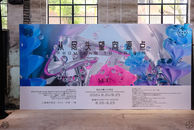From
End
to
Origin
The theme of the exhibition, From End to Origin, invites us to look back from the end to the beginning, or from the future to the past. The verb ‘to look’ encompasses a complex relationship between time and space. Spatially, it transcends geomorphic features and exists purely in a topological field, while temporally, it connects the past, present, and future. Imagine the world placed within a thermos with an open lid, granting an unobstructed view of everything inside. This exhibition focuses on the inheritance, present, and future of Eastern and Western cultures from this unified spatial and temporal perspective.
What is inheritance? Wu Guanzhong, widely recognised as a founder of modern Chinese painting and one of the first Chinese artists to study Western art abroad, offers a compelling example. His artworks display both Western and Eastern influences, such as the Western style of Fauvism and the Eastern style of Chinese calligraphy. This exhibition juxtaposes his art with that of contemporary artists, illustrating the impact of globalism on contemporary art and the legacy of cultural exchange that began in the early years of the People’s Republic of China. By integrating local and foreign influences, contemporary artists carry forward the spirit of their predecessors, enriching the complexity of Chinese identity. This cultural inheritance and integration are essential features of Chinese contemporary art.
What constitutes the present moment? The exhibition presents a comprehensive overview of Chinese art, encompassing a diverse array of mediums and techniques, including Chinese painting, integrated painting, ceramics, installation, glass, and new media art. The dialogue between these diverse forms illuminates the evolving state of artistic practice in the context of cultural inheritance and exchange. This is exemplified by artist Shao Yong’s multi-medium Chinese paintings. The accelerated pace of globalisation and the proliferation of information technology and economic exchanges have progressively diminished the sharp delineations between cultural entities. At this pivotal juncture where Chinese and Western cultures converge, it is imperative not only to examine our cultural traditions but also to adapt to the global cultural milieu. Art acts as a mirror, reflecting the multifaceted, intricate, and inclusive nature of society, providing fertile ground for creativity and limitless potential for future artistic evolution.
What, precisely, is the future? The exhibition also incorporates virtual costumes, virtual spaces, and interactive augmented reality (AR) installations. This represents a novel synthesis of art, technology, and commerce, which can be understood as the ‘End’ in ‘From End to Origin’ or, in other words, the future. The integration of digital technology and interactive installations offers novel opportunities for audiences to engage with sensory experiences. Forthcoming art will transcend single cultures and disciplines, embodying the essence of multiculturalism and interdisciplinarity. The pioneering practices of earlier artists foretold this trend, which will be further advanced by contemporary and future artists, enriching the diversity of the art world. Their works are not solely a continuation of the past and present, but also a bold exploration and anticipation of the future.
This exhibition delves into the dynamic interplay between Eastern and Western cultural traditions across various historical periods. The artistic practice of Wu offers valuable insights and references. Today, artists explore identity and social change within the context of globalization. Looking ahead, art will diversify further, with artists creating novel artistic languages and forms through cross-disciplinary inquiry. This exhibition is a dialogue across time and space, reflecting on tradition, the present, and the future. The audience is invited to join the artists in this unified, condensed space and time to explore the origin and end of culture.




















